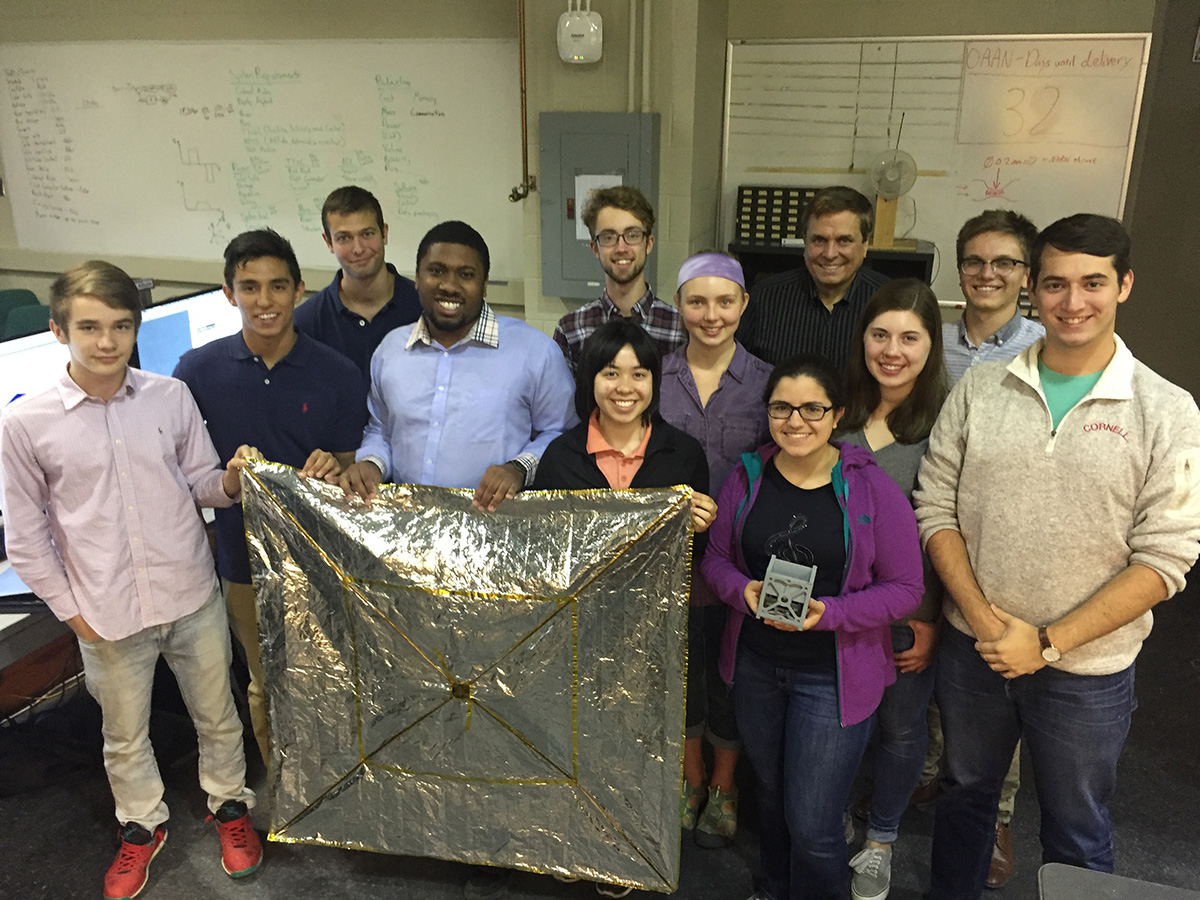Ithaca High CubeSat team's concept to get a shot at space
By Tom Fleischman

Six months ago, Ithaca High School sophomore Isabel Dawson had no interest in space exploration. But that changed after Mason Peck, associate professor in the Sibley School of Mechanical and Aerospace Engineering, gave a lecture at the high school.
A friend who had attended the lecture told Dawson about it.
“My friend said that this guy had come down from Cornell, and that he had worked at NASA,” Dawson said, referring to Peck’s two years as chief technologist at the National Aeronautics and Space Administration. “And he talked about how there was this contest where you could design and hopefully build your own CubeSat. I was like, ‘What’s a CubeSat?’”
Not only did Dawson learn what a CubeSat is, she led an Ithaca High team that in May was one of three winners in an international contest to design a science fiction-inspired version of the grapefruit-sized satellite.
Dawson and her CayugaSat teammates will be in National Harbor, Maryland, on July 2 for the Escape Velocity Science Fiction Convention, hosted by the Museum of Science Fiction. The other winning teams came from Bowie High School in El Paso, Texas, and Dulwich School in Suzhou, China.
Cornell CubeSat Team
Principal Investigator: Mason Peck, associate professor of mechanical and aerospace engineering
Administration: Erica Miles, associate director, New York Space Grant
Concept creator: Isabel Dawson, sophomore, Ithaca High School
Chief engineer: Lorraine Weis, graduate student in aerospace engineering
Engineers (Cornell students unless noted): Willard Andrews ’16, Zach Bialik ’18, Segun Fontenot ’17, Emma Fraley (Oregon State), Annika Hanson (Smith College), Karen Kuhlman (Oregon State), Eric Pohl (Colgate), Niccolo Porcari ’16, Adler Smith ’17, Christina Xu ’19
In addition to receiving an award at the convention, each team will see its design developed into a working CubeSat by a university-based team of aerospace engineers, for a possible launch into orbit through NASA’s CubeSat Launch Initiative.
Just months after first hearing the term “CubeSat,” Dawson is now part of Cornell’s Breakthrough Starshot CubeSat team, which is incorporating aspects of Dawson’s concept – a cracker-sized satellite known as a “chipsat,” powered by a solar sail – into their own CubeSat effort.
Members of Peck’s team are impressed by the Dawson-led CayugaSat concept.
“It seems very well thought out,” said Segun Fontenot ’17, a mechanical engineering major and one of 11 undergraduate and grad students on Cornell’s CubeSat team. “We’re modifying the details a bit to better suit our goal.”
That goal is to boldly go where no satellite development team has gone before: to build a satellite, completely with off-the-shelf components, and go from design to completion in 10 weeks, at a cost of $10,000.
“I think the current fastest time is about six months, so we’re trying to beat that by a factor of two or three,” said team member Adler Smith ’17, a mechanical engineering major.
Fontenot and Smith are among the seven Cornell students on the team; four non-Cornell undergraduates are here through internships funded by the New York Space Grant Consortium.
Peck is the team’s principal investigator; also onboard is Silicon Valley inventor and NASA consultant Andy Filo, who designed the CubeSat’s solar sail.
Peck is on the board of advisers for the Museum of Science Fiction and was lead judge for the high school competition, but recused himself from ranking this particular submission to ensure that his role did not give the local team an advantage. What convinced the judges, he said, was the group’s work, based on the existing concept of solar or laser “sails.” These sails are giant, flat sheets of very thin, reflective material – 40 to 100 times thinner than a sheet of paper – that use photons from sun or laser light for energy.
“Up until a few months ago, laser sails were very much the stuff of science fiction,” Peck said. “There has been some engineering theory developed about it, but nothing particularly real.”
The Cornell team’s solar sail will measure 13 feet square and weigh approximately a half-ounce, by far the best surface area-to-mass ratios of any solar sail ever launched, Peck said.
Peck is also on the advisory board of Starshot, one of three Breakthrough Initiatives (along with Listen and Message) founded in 2015 by Russian entrepreneur Yuri Milner and his wife, Julia Milner, to explore the universe and encourage public debate from a planetary perspective.
Ithaca High’s winning CubeSat proposal, despite being predicated on science fiction, is in line with the goals of this ambitious endeavor, Peck said.
“Their idea is exactly consistent with this Breakthrough Starshot project,” he said, “and they very successfully talked about what could be done to demonstrate the basic concept.”
This summer figures to be an intense one for Peck’s team, which hopes to see its design head into space by next summer. Once the CubeSat is complete, it must go through compliance verification from NASA and other government agencies, then take its place in the queue of other satellites looking for a ride into space on a regularly scheduled rocket launch.
“The thinking is that if we’re done in 10 weeks, we could be up in a year,” Smith said. “That would be really cool because everybody would still be around to man the ground station.”
Media Contact
Get Cornell news delivered right to your inbox.
Subscribe